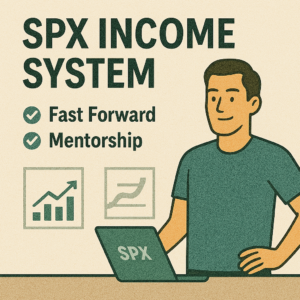 Ahoy there, Trader! ⚓️
Ahoy there, Trader! ⚓️
It’s Phil…
Have you ever placed a trade, only to wonder 10 seconds later if it was the right one? You’re not alone. Most traders spend hours flicking through charts, chasing tips, and making gut decisions disguised as “analysis.”
But what if I told you there’s a way to trade SPX options that:
-
Limits your risk
-
Pays you upfront
-
Takes 2 minutes a day
-
And works even if you have no idea where the market’s headed?
That’s the power of the SPX Credit Spread strategy – when it’s paired with the Pulse Bar.
Let’s dive in…
What Is an SPX Credit Spread (And Why It Works So Well)?
A credit spread is a trade where you:
-
Sell one option
-
Buy another one further out-of-the-money
-
And collect a net credit upfront.
The best part? You’re not predicting direction like a fortune teller. You’re getting paid to say, “I think the market won’t reach here by the end of the day.”
There Are Two Versions:
-
Put Credit Spread = You expect price to go up (or stay above).
-
Call Credit Spread = You expect price to go down (or stay below).
Enter the Pulse Bar: The Ultimate Setup Trigger
Here’s what makes your strategy better than 99% of what’s out there.
Instead of 37 indicators and 6 timeframes, you use one bar:
✅ A Pulse Bar = a candle that closes in the top or bottom 5% of its range.
That’s it.
-
Top 5% close? → Bullish → Sell Put Credit Spread
-
Bottom 5% close? → Bearish → Sell Call Credit Spread
Simple. Visual. Zero guesswork.

️ How To Place the Trade (Step-by-Step)
Step 1: Identify a Pulse Bar
Look at the 30-min chart during the first two hours after the market opens.
Step 2: Determine Direction
Top = bullish → Put Spread
Bottom = bearish → Call Spread
Step 3: Choose Strikes
-
Sell a strike 10–15 points away from current price
-
Buy a further OTM strike
-
Aim for $$2.50 in premium on a $5-wide spread
Step 4: Place the Trade
You now have a defined-risk, cash-settled trade with a capped max loss.
Step 5: Manage or Let Expire
If the market behaves, do nothing. Let the spread expire worthless and keep the credit.
Or, close early when you’ve captured 70–90% of the max profit.
Risks – And Why You’re Covered
Traditional credit spreads scare people because:
-
“What if the market moves fast?”
-
“What if there’s a gap down?”
-
“What if I get assigned?”
But here’s why that doesn’t matter with SPX Credit Spreads:
-
Cash-settled → No assignment risk
-
Zero-day expiry → You’re in and out in hours
-
Fixed max loss → You can never lose more than the spread width minus the credit
And since your entire setup is mechanical, there’s no guessing, hoping, or praying. It either fits the rule, or it doesn’t.
⚙️ Tools You’ll Want
-
Broker Platform: For placing trades (Tastyworks, Thinkorswim, Interactive Brokers, etc.)
-
Charting: TradeStation or TradingView with Pulse Bar indicator (included in your system).
-
1-Page Cheatsheet: For checklist and trade steps (comes with SPX Income System).
Extra Edge From The System
✅ 100% Rule-Based: No guessing. You just follow the checklist.
✅ Trade in 2–3 Minutes a Day: Spot the pulse bar, place the trade, and walk away.
✅ No Chart-Hopping: You look at one chart, one timeframe, one setup. Done.
✅ Results-Backed: 2,000+ trades backtested over 15 years.
✅ Mentorship & Software Access: If you’re in the Fast Forward Group, you have Phil’s personal oversight, plus custom-coded software for TradeStation & TradingView to automate your trade signals.
Fun Market Fact: SPX Options Are the Supercar of Income Trading
SPX options are cash-settled, trade daily, and are European-style, meaning no early assignment. That’s why hedge funds love them. And now, so can you.
Oh, and if you want to trade with smaller size? Use XSP – the mini version of SPX. It’s 1/10th the size, but packs the same punch.
Want to Trade Like This?

I teach this strategy step-by-step in the SPX Income System – a rule-based approach for generating income using short-dated credit spreads.
-
No guesswork.
-
No chart-hopping.
-
No 3am doomscrolling.
Just simple, structured trades…
That can potentially pay you $250 to $1,000+ per week.
- Option 1: The Book (Just $12)
A complete guide to the system.
Written to be clear, concise, and immediately actionable.
>> Get the Book Here
- Option 2: Full Course + Software Access – 50% Off
Includes the video walkthroughs, tools for TradeStation & TradingView, and everything I use daily. Plus 7 additional strategies
>> Get DIY Training & Software
Join today and I will personally hop on a quick start call with you to get setup and running in my system in less than 45-mins.
- Options 3: Join the Fast Forward Mentorship – 50% Off
>> Join the Fast Forward Mentorship – trade live, twice a week, with me and the crew. PLUS Monthly on-demand 1-2-1’s
No fluff. Just profits, pulse bars, and patterns that actually work.
